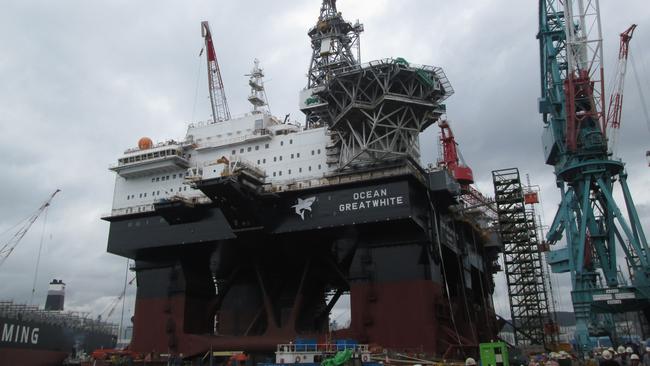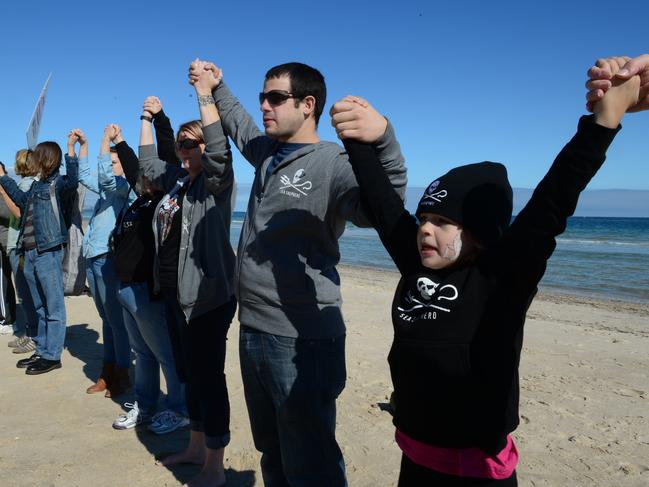BP abandons Great Australian Bight drilling program
BP has abandoned exploration in the Great Australian Bight, dashing hopes for an oil find to boost the SA economy.

Oil giant BP has pulled the plug on a $605 million oil exploration program in the environmentally-controversial Great Australian Bight, dashing hopes for a big oil discovery to give the ailing South Australian economy a boost.
BP denies that the abandonment of its planned drilling program in the waters off SA is a result of tardiness in receiving necessary federal government clearance for the program, or that it has bowed to fierce campaigning against the program by environmental groups.
BP today instead blamed the decision on the low oil price environment and better options in its global portfolio.
“This decision has been incredibly difficult and we acknowledge it will be felt across the South Australia region,’’ BP said in a statement.
The decision is nevertheless a turnaround from BP’s position last week when it was questioned on delays in approvals from regulator the National Offshore Petroleum Safety and Environmental Management Authority (NOPSEMA).
“We will commence our exploration drilling program once all necessary regulatory approvals are in place, our onshore infrastructure is completed, and our contractors are ready to begin,’’ BP said last week.
Apart from the NOPSEMA delays, BP’s decision to walk away from what analysts consider to be the last chance for Australia to boost its self-sufficiency by discovering big oilfields in the frontier basin, comes as exploration in the Bight remains the subject of a Senate inquiry, due to report back in March next year.
BP’s drilling plans in the (GAB) were the most advanced planned for the region.
All up, more than $1.2 billion had been earmarked by BP and others companies — including Chevron and Santos — to test whether the Bight does in fact contain big oilfields.
The BP program has been held up pending clearance from NOPSEMA which recently requested more information on the drilling program, which involved the Stromlo-1 and Whinham-1 exploration wells. BP had until October 28 to provide the information, or seek an extension.
Campaigning against the BP plans has the added piquancy of the group being the operator of the Deepwater Horizon disaster six years ago in the Gulf of Mexico, in which 11 people died and widespread environmental damage was caused.
Last week industry group the Australian Petroleum Production and Exploration Association said it was time for the billions of dollars that could be spent on looking for big oil in the Bight to be unleashed.
Speaking after the release of figures showing oil exploration expenditure had collapsed to 10-year lows as a result of the slump in oil prices, APPEA chief executive Malcolm Roberts said the fall in exploration spending was alarming.
“Today’s exploration is tomorrow’s production. Companies prepared to invest heavily in exploration should be allowed to get on with the job under proper regulatory oversight,’’ Dr Roberts said.
“Successful oil exploration in the Grreat Australian Bight, for example, would ease Australia’s reliance on imported oil and deliver South Australia much-needed new investment and jobs,” he said.
BP said today the decision to pull the plug on drilling followed a review and refresh of its exploration strategy which included “focusing exploration on opportunities likely to create value in the near to medium term.’’
“BP has determined that the GAB project will not be able to compete for capital investment with other upstream opportunities in its global portfolio in the foreseeable future,’’ said Claire Fitzpatrick, BP’s Managing Director for Exploration and Production, Australia.
“We have looked long and hard at our exploration plans for the GAB, but in the current external environment, we will only pursue frontier exploration opportunities if they are competitive and aligned to our strategic goals.
“After extensive and careful consideration, this has proven not to be the case for our project to explore in the Bight.”
BP said joint venture partner Statoil understood BP’s change in strategy.
“BP is a long-term, significant investor in Australia, most visibly through our retail network
and refinery and also as a participant in the North West Shelf and Browse ventures,” added
Ms Fitzpatrick. ”We expect to continue to consider further opportunities to invest and grow our
business here.”
The Wilderness Society and Greenpeace welcomed BP’s retreat from the Bight.
“All oil and gas companies should follow BP’s lead,’’ the Wilderness Society said.
“Australia’s offshore oil and gas regulator, NOPSEMA, has sent back BP’s application to drill in the Bight three times. If BP with all its experience cannot produce an acceptable drilling plan for NOPSEMA, the remaining companies exploring in the Bight will be wasting their shareholders’ money trying to pursue this folly,” said Wilderness Society National Director Lyndon Schneiders

BP was first awarded exploration licenses to four blocks in the Ceduna area of the Great Australian Bight in January 2011.
BP had, however, met resistance as it sought environmental approval to begin drilling two exploratory wells in the region.
The prospects of further activity were severely damaged after BP released a report into a potential oil spill should a development proceed, which showed in a worse-case scenario a Deepwater Horizon-like spill may take over six months to get under control.
The study also found a “high probability” a spill would significantly affect marine life, including sperm whales, sea lions and pygmy blue whales.
BP tagged the report as “highly conservative”, but regardless of the extent of the potential damage was significant, with the prospect of oil reaching landfall considered a certainty.
The oil giant had been considering pressing forward with exploration despite the risks and depressed market conditions given a prize on offer considered to be worth over $100 billion.
A report from consultants Wood Mackenzie in April found potential oil resources pointed to the prospect of benefits akin to those seen in the Bass Strait over the past four decades.
In all, estimates for the Great Australian Bight revealed a potential resource of 1.9 billion barrels of oil equivalent, worth around $US84bn ($111bn).


To join the conversation, please log in. Don't have an account? Register
Join the conversation, you are commenting as Logout